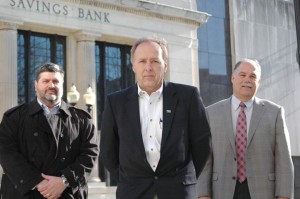
As he pored over Bridgeport Historical Society blueprints of the former Mechanics and Farmers Bank building, Michael Marcinek”™s gaze was drawn to a onetime skylight that had since been cemented shut.
In opening up the M&F Bank skylight to the heavens once more, Marcinek and his colleagues may be shedding light on a new day in Bridgeport.
With plans to return to Bridgeport after a 10-year sojourn in Shelton, architecture firm Fletcher-Thompson Inc. is punching a hole in the argument that downtown Bridgeport cannot attract high-end professional services companies. Despite the move likely costing the company and its employees in the form of higher taxes and parking, Fletcher-Thompson”™s designers liked what they saw in the architectural blank slate that is the stone M&F Bank building at 930 Main St. as it mulled a lease approaching its 2014 expiration date. The move will bring it back to the city where it was founded in 1910.
“A year ago, we said 2014 is going to come upon us before you know it,” said Marcinek, managing principal in Fletcher-Thompson Shelton”™s office. “If we wanted something that meets the creativity of our architects, the time is now.”
That is welcome news for Bridgeport, whose day in the sun to some seems perpetually over the horizon, several years in the future. From the stalled Steel Point waterfront development to the swaths of vacant industrial properties and lots dotting its streets, Connecticut”™s largest city needs nothing less than an extreme makeover ”“ with few established businesses lending a hand by relocating there.
Similar challenges have faced urban planners throughout Connecticut and the Northeast, however, who have responded with South Norwalk”™s SoNo retail and gallery district; Stamford”™s Harbor Point district, which drew Design Within Reach from San Francisco, among other trendy spots and employers; and Brooklyn, N.Y., where the Dumbo (Down Under the Manhattan Bridge Overpass) district has emerged as a major locus for the creative arts as well as tech startups.
“I can”™t figure out why no one is turning Bridgeport into the next Brooklyn,” said Marian Salzman, CEO of the Havas subsidiary Euro RSCG in Wilton. “We know it can be done in Dumbo.”
Connecticut”™s largest city has reeled in one award from the Connecticut Main Street Center urban revitalization group based in West Hartford. It came in its second year as a member of the organization while hosting the group”™s awards presentation in 2010. That year, Forstone Capital and Spinnaker Real Estate Partners were recognized for their rehabilitation of the Casey Family Services building in downtown Bridgeport.
New Canaan-based Forstone happens to own the stone M&F Bank edifice Fletcher-Thompson chose for its new Bridgeport locale.
Bridgeport”™s “bones” have been prized by a few other creative companies, notably Antinozzi Associates, which redesigned the former Bijou Theater as an architecture office. Marcinek does not expect a rush back into the city based on Fletcher-Thompson”™s move, but thinks it could happen in time.
“It is happening,” argues Tom Santa, CEO of Santa Energy in Bridgeport. “You”™ve got 600 brand new, market-rate apartments in and around the downtown which are for the most part full. ”¦ In the last five years, I”™ve seen life coming back into Bridgeport and the lead demographic is single women.”
John Simon recalls observing a similar dynamic while attending a Philadelphia conference in his role as CEO of Connecticut Main Street Center, and noting women”™s comfort level on the streets in the later hours of the night.
“Perceptions are not easy to change, but the ”¦ best indicator of a vibrant, healthy downtown is people on the street,” Simon said. “When you have a place that”™s teeming with people walking around ”“ even if you have a few panhandlers, they get lost in the larger crowd.”















